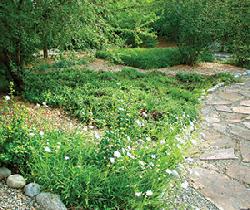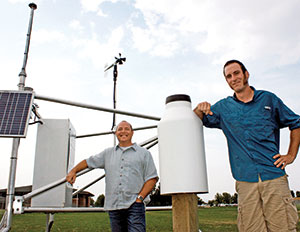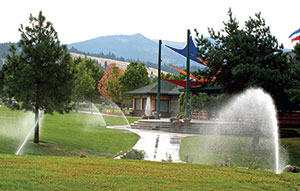 |
Long an ambassador of water efficiency and conservation, the Liberty Lake Sewer and Water District maintains a xeriscape garden at its Denny Ashlock administrative building. The garden illustrates landscaping alternatives that significantly reduce water usage.
|
More News
March Marvel-Calvary a catalyst for historic Gonzaga run
In Gear for Good
Kramer puts integrity first at Christian Brothers
City commissions offer chance to serve, enhance community
When Danetta “Dg” Garcia’s bid for a Liberty Lake City Council seat fell short, she didn’t give up on the idea of serving the city she calls home.
TT's Brewery and Barbecue Expands to Neighborhood Liberty Lake Location
In the smoky realm of barbecue, TT's BBQ has carved a niche for itself as a beacon of mouth watering flavors and culinary expertise for both their beer and food.
Daughters of The American Revolution
The Daughters of the American Revolution (DAR) is a volunteer women’s organization that has been dedicated to historical preservation, education, and patriotism for over a century. Across the United States, there are over 3,000 chapters supporting an estimated current membership of 200,000, with over one million total members since their founding in 1890.
HOA’s have different rules what it means for Police and streets
The city of Liberty Lake is known for its winding paths, street trees and homeowner’s associations. Recently, however, residents of some neighborhoods have been questioning the services they receive from the city, particularly police patrols and traffic enforcement.
Vietnam Veteran Pat Payne Receives his Combat Infantry Badge
Spokane Valley resident and Vietnam Veteran Pat Payne personifies bravery, resilience, and a profound commitment to supporting his fellow service members. Having served in the Vietnam War, Pat received both the Bronze Star and Purple Heart medals for his exceptional contributions and sacrifices. Unfortunately, at the time of his service discharge, a key ‘box’ was left unchecked, and he did not receive his Combat Infantry Badge or CIB until fifty-six years after leaving Vietnam.
Return Ticket Home; Fisher helped establish LL city roots
In the acclaimed 1940 novel, “You Can’t Go Home Again,” author Thomas Wolfe paints the picture of ambitious writer George Webber who leaves his rural hometown roots to seek fame and fortune in New York City.
At Home on Air – Media fixture Owsley relishes local roots
Sean Owsley’s first big break in the media world came when he was living in a modest apartment on Skipworth Road in Spokane Valley.
Spokane Valley Library employee is recognized by the Library of Congress
Spokane Valley Library was recently honored to receive a Certificate of Appreciation from the Library of Congress for its involvement in the Veterans History Project. The Library of Congress recognized the library's continuous dedication to preserving the stories and experiences of our nation's veterans. As part of this recognition, Congresswoman Cathy McMorris Rodgers presented a Certificate of Appreciation to Jeremy Mullin, a local resident actively involved in the project.
Council social media training degenerates into confrontation
Spokane Valley City Council training on policy regarding social media accounts and use of the city’s logo turned from benignly informative to heatedly combative after an exchange between two council members at the Jan. 9 meeting.
Central Valley School District Prop. 1
Eat, Shop, and Be Merry
Water Works
2023 Candidate Guide
Sporting in Liberty Lake
Closing the Chasm
Congratulations First Ridgeline High School Graduating Class of 2023
2023 Liberty Lake Kiwanis Yard Sales are Coming!
Click here to register today! Only $15 to get into the printed and online guide!
Public Safety Raised to New Level
Parks and Art Commission
Looking Ahead to 2023
Eat, Shop and Be Merry
New city administrator
Liberty Lake Kiwanis Yard Sale Interactive Map!
Liberty Lake Kiwanis Yard Sale Guide - Now Available!!
Conrats 2022 Senior Graduates
Pavillion Park
You Are Invited
Destination Liberty Lake
Liberty Lake's Lego Home
Making and Impact 2022
|
|
|
|
Cover Story: H2O 101
7/30/2015 9:10:17 AM
Story and photos by Craig Howard
Splash Contributor
Along with Hoopfest, Ironman and the Windermere Marathon, the start of summer in the Inland Northwest featured weather patterns more common in Lake Tahoe than Liberty Lake.
With temperatures hovering in the 90s to 100s for much of June, irrigation at residential and commercial properties rose right along with the barometer. For many property owners, a version of "Waterfest" occupied most of the month with sprinkler systems ramped up to combat sweltering conditions and the accompanying toll on yards attempting to stay hydrated.
Last June, the Liberty Lake Sewer and Water District distributed 149.5 million gallons of water. This June, the total rang in at 268 million gallons.
"Landscapes will need more water when they're not receiving water from the atmosphere and the temperatures are 100 degrees," said BiJay Adams, LLSWD general manager. "In June, there was about an inch of rain in Liberty Lake. There was a lot of reaction to the temperatures and trying to maintain landscapes, but with that there's the potential for over-usage."
Relying on the robust resource of the Spokane Valley/Rathdrum Prairie Aquifer, residents of Liberty Lake and the surrounding region are not facing the water crisis affecting California and other western states dependent on the Colorado River Basin. Still, some area cities like Cheney, which has its own water and sewer utility, have introduced a moratorium on irrigation at certain points this summer. To the east, Post Falls and Hayden Lake irrigation districts have implemented watering schedules that alternate odd and even days, depending on the neighborhood.
Locally, the St. Joe River Basin, the Clark Fork River Basin and the Coeur d'Alene River Basin feed the aquifer. Lack of snowfall, like that seen in last year's mild winter, can lead to long-term depletion that impacts water availability in the Spokane area.
"The St. Joe River, which ultimately empties into Lake Coeur d'Alene, is 25 percent lower than its lowest level in 92 years," said Adams. "Most all of the rivers are at their lowest levels in recorded history. Absence of snow and rain, combined with higher than normal temperatures mean these rivers across the Northwest are having some of their lowest flows ever."
Despite some less-than-encouraging trends, Adams and others at LLSWD emphasize the district's storehouse of water - based on a network of reservoirs - is quite sufficient even during peak usage. More than 50 percent of the district's annual water distribution comes during the four-month period of June through September.
"Most of that is irrigation," said Jeremy Jenkins, LLSWD Lake Protection/Water Resource manager. "When everyone is watering double just to keep their grass green, that's when it puts a big stress on the system. Here, we don't have that much of a problem, because we have a lot of storage."
Having the reliability of an underground water source like the aquifer has been a boon, Jenkins said.
"There are certainly some areas in the Northwest that have some restrictions based on the water supply," he said. "These are areas that are relying on surface water, and that source is supplied by snow. So, when you don't get any snow, you have a limited supply."
Education leads to efficiency
Before he joined the LLSWD board of commissioners, Steve Skipworth served as director of operations at Vera Water and Power and chaired the Washington Water Utilities Council, putting him at the center of discussions involving water policies on the state and local level. He was part of a committee that established statewide rules for water use efficiency under the Municipal Water Law passed by the legislature in 2003.
"With our aquifer, we always need to educate the public on what it is and why we need to protect it," Skipworth said. "I think the Spokane Aquifer Joint Board does a pretty good job of educating the public. As far as entities other than the water systems, we sometimes need to give them a little nudge to help them understand that what they are doing could impact our water source."
In 2009, LLSWD introduced a program to distribute free irrigation sensors to the district's heaviest water users. LLSWD also offers water audits to customers at no cost. In-home devices like low-flow showerheads and faucet aerators that set the flow at a frugal 1.5 gallons a minute are also part of the district's outreach efforts.
"We want people to understand that you should be efficient with the resource," Adams said. "You wouldn't run your air conditioner or your heater full blast; why do it with your water? When we see numbers like we saw in June, it's a concern to us because it costs us a lot more to deliver this water."
Certain approaches rely on common sense, such as not irrigating when the sun is bearing down.
"There are definitely some best practices to maximize the water you put on," Jenkins said. "Don't water during the day. It's like pouring water on a hot pavement. I see a lot of commercial buildings that do a lot of irrigation during the day. I think they would see impacts on their bills if they actually changed to watering more at night."
Despite the messaging, Adams and Jenkins say they still both see residential and commercial sites that water during the day when absorption is at a minimum.
"It's not only wasteful of your water, it's inefficient for your plants," Adams said. "When you talk about turf health, it's better for your landscape if you water at night. You're going to keep that soil around the roots saturated for longer."
Sprinklers, timers and sensors
While watering in the daytime is one of the district's pet peeves, Jenkins also cringes when he sees sprinkler systems operating when it's raining or windy. LLSWD offers sensors that, in Jenkins' words, "push the pause button on your irrigation timer based on conditions in the environment." A rain sensor shuts off sprinklers when there have been high levels of precipitation. A soil moisture sensor gauges the water in the ground and will suspend irrigation accordingly.
"We think integrating things that can measure the outside conditions into your irrigation system is only going to improve the efficiency and save money," Jenkins said.
Adams said it's vital for property owners to be knowledgeable about irrigation timers and their effect on watering efficiency and cost.
"Sometimes, we'll go out to a home that is a couple of years old and the irrigation timer is still set for new turf and those requirements are much higher than established turf," he said.
Keeping watch on a sprinkler systems can mean significant savings in the long run, Jenkins said.
"You need to watch what you're doing periodically to check if your system leaks, like if you accidently ran over one of your sprinkler heads with a lawnmower," he said. "A broken sprinkler head can lead to over 6,000 gallons of water over the course of a summer."
As the education continues, Skipworth said he is encouraged by the strides the community has taken in water conservation and awareness in the time he has been with Vera and LLSWD.
"Being in the water game for over 40 years, I have seen the Valley including the Liberty Lake community go from dumping water on the ground to being aware of how they use it," he said. "We still have a ways to go, and we will always need to remind the community about water use."
Low rates, expanded service
As Liberty Lake has grown, so have the district's efforts to keep up with the community's demand for water. In 2001, the year Liberty Lake incorporated as a city, LLSWD provided just over 711 million gallons of water to 1,841 connections. By 2008, those numbers had risen to nearly 993 million gallons and 2,635 connections.
Last year, the district distributed 1.09 billion gallons to 3,046 connections. On some level, the expansion has meant supplying less water, Adams said, as larger agricultural expanses with high water needs are replaced by residential developments with smaller landscapes.
Despite the growth, LLSWD continues to charge the lowest base rate for water in the region at $10.59 a month after tax. The cost has not shifted since 1994. In 1980, the rate stood at $10 a month. By comparison, the city of Spokane charges $14.50 while other utilities like Pasadena Park Irrigation District #17 ($32.33) and Orchard Avenue Irrigation District #6 ($35.29) feature even higher monthly charges.
Over time, LLSWD added a tiered system which means customers pay more after a certain level of usage. Usage above 976 cubic feet per month (1 cubic foot equals 7.48 gallons) is charged at the next tier, while water over 3,131 cubic feet goes up another step.
Jenkins notes that inexpensive, readily accessible water can make it a challenge to implement conservation themes in Liberty Lake.
"We're not wasting a lot but there are efficiencies that could be had with just a few changes," he said. "We're not helping matters with cheap water. That doesn't really change behavior and that's what we're talking about here is change in behavior from what you've been doing to optimize."
LLSWD is currently conducting a water rate study that Adams said will determine the future of foreseeable costs to ratepayers. A decision on a rate change is expected within a year.
"We're looking at operation and maintenance costs, including what capital upgrades are needed," Adams said. "We emphasize water conservation with our customers, but the cost of water also depends on how efficient the utility is that's providing it. We want to provide economical water. We're dually responsible to be as efficient and economical as possible with the way we operate and with our ratepayers' money so we can continue to have low rates."
• • •

From left, the LLSWD's BiJay Adams and Jeremy Jenkins stand alongside "AgriMet," an automated agricultural weather station located near the Liberty Lake Ballfields.
|
Station sheds light on LL's irrigation terrain
By Craig Howard
Splash Contributor
Just beyond the fences at Liberty Lake Ballfields, spectators may notice a contraption that looks like a cross between a small space station and a monster-sized mechanical spider.
The enigmatic machine is known as "AgriMet," an automated agricultural weather station designed to determine ideal irrigation levels for everything from wheat crops to the infield grass on a baseball diamond. The version in Liberty Lake was installed in a field off Country Vista Road in October as part of a network of over 100 stations in seven Western states maintained by the U.S. Bureau of Reclamation.
Liberty Lake Sewer and Water District General Manager BiJay Adams said "it was a matter of being in the right place at the right time" when the aquifer protection district in Kootenai County announced a micro-climate study and sought a Spokane-area site for AgriMet to go with five locations in North Idaho.
"I said, ‘How about Liberty Lake?'" Adams recalled. "We have a lot of turf around, and the district has been very active in water use efficiency over the years."
The station determines something called "agronomic rate" - or the optimum water levels for growing crops. The real-time data is updated 15 minutes and can be used to promote water use efficiency on residential and commercial landscapes. AgriMet collects temperature, wind speed and direction, solar radiation and precipitation. From that data, "evapotranspiration" is determined, or how much water evaporates and what quantity is actually utilized by turf and plants.
"If you want to know how much water to put on your lawn over a week, it's going to look at those numbers and come up with a setting," said LLSWD Lake Protection/Water Resource Manager Jeremy Jenkins. "The power of this is not just giving your turf optimal conditions. There are thresholds you can set. So, if we've received a large amount of rain over a short period of time, I'm not going to water. I'm going to wait a little bit."
One of the goals with AgriMet in Liberty Lake is to eventually establish connections with smartphone irrigation scheduler apps that allow homeowners to automatically set timers based on the most current and relevant information.
"We're trying to figure out something that's easily consumable by our customers, something that's not overly expensive and works well," Jenkins said.
The city of Liberty Lake is also on board with AgriMet, hoping to eventually incorporate the information to improve watering practices. The district partnered with the city to place the station in an area that could be used by multiple entities, including Trailhead and MeadowWood golf courses. Cost of the station was covered by the USBR grant.
"Where that station is, it's very representative of conditions that one would see at any corner of Liberty Lake," Adams said. "I think this will be an asset to us."
• • •

Described as the "gem of the city," crews work especially hard at evaluating irrigation practices at Pavillion Park.
|
City strategic about keeping popular greenspaces green
By Craig Howard
Splash Contributor
The flourishing carpet of green turf that defines the amphitheater at Pavillion Park hardly happens with a wave of the magic irrigation wand.
Just ask Jennifer Camp.
As Liberty Lake's parks and open space superintendent, Camp and her crew closely monitor landscape conditions at all of the municipal greenspaces, prescribing a particular approach based on soil structure, microclimate and turf health. Careless, inefficient watering is not part of the agenda.
"In the early spring when the weather is cooler, turf grass in this area requires much less moisture than at the peak of summer," Camp says. "Every attempt is made to follow those weather patterns and only give the turf what it needs to ensure proper moisture to keep the turf healthy."
When it comes to the city's water game plan, Camp is aware her crews represent Liberty Lake's most visible irrigators, both in terms of results and practices. Whether it's the resident she spoke with this summer who watered frequently when lack of fertilizer was the actual problem, or homeowners who fail to adjust their irrigation clocks according to the season, Camp sees watering approaches run the gamut.
"I know homeowners who have irrigation systems and they set their irrigation clocks one time a year and walk away, not realizing that water requirements are less in the spring, higher in the summer and less in the fall," she said. "A common misconception is that if turf grass is brown and dried up that it is dead. It takes quite a period of time for lawn turf to die without water. What happens is that is actually goes into a dormant state to preserve and protect its root system. Even when the turf is brown from lack of water, often times it will green back up in a short period of time if water is reintroduced."
Along with Pavillion Park, Trailhead Golf Course, Rocky Hill Park and the recently completed Liberty Lake Ballfields are the city's largest consumers of water. While crews focus on conservation, Camp says "no two areas in the city are alike, and each is maintained a little bit differently than the other."
The city has worked with the Liberty Lake Sewer and Water District to install soil moisture sensors to achieve optimum irrigation levels. In the last two years, the city has incorporated additional technology to add watering efficiencies. Broken sprinkler heads are repaired right away.
"We are continuously watching the weather and making adjustments according to temperature, precipitation and humidity," Camp said. "Healthy turf and soil structure also play an important role in water conservation. If turf is healthy, it will be able to better withstand the stresses of long, hot summers like we have this year. Our soils around the city range from sandy to valley rock, and irrigation in each area is maintained according to how quickly the soils drain and their capacity to hold moisture."
At Pavillion Park, the city's most popular recreational and entertainment site, water is culled from a nearby well also utilized by MeadowWood Golf Course. Hand watering is often utilized for stubborn brown areas. The equation is made more complex by the steady foot traffic and crowds that gather for movies and concerts throughout the summer.
"Pavillion Park is the gem of the city, so the expectation is greater than any other area we have," Camp said. "Overall, irrigation is our highest priority in the summer because without the water, we have nothing."
Advertisement

|
